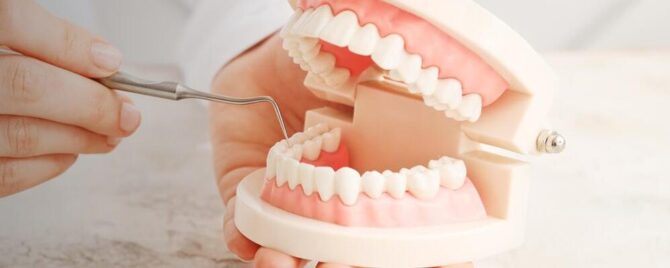The term is derived from the Greek words “Dys” for “Miss” and “gnathós” for “jaw”. Dysgnathia summarizes all symptoms that occur due to a misalignment of the jaws, the teeth or a malfunction of the chewing apparatus. What are the underlying causes and what healing options are there?
- Dysgnathia can be congenital or acquired.
- Symptoms of dysgnathia are far-reaching and are not necessarily associated with it from the start.
- In the case of an operation, the duration of treatment, including preparation and follow-up, can be up to four years.
- Since dysgnathia is seldom an exclusively cosmetic operation, the health insurance companies assume the expenses if a treatment and cost plan is available.
Causes of Dysgnathia
On the one hand, dysgnathia can be congenital. The jaws are not lining up properly or the teeth are not standing as they normally should. Both can be the cause of chewing or speaking disorders.
On the other hand, there are the so-called acquired malpositions. These primarily concern the position of the teeth. They result from:
- using a pacifier for too long
- Thumb sucking
- press your tongue against your teeth
Dysgnathia often develops during the period of growth, when the jaws do not develop in parallel at a young age.
Forms of dysgnathia
Medicine distinguishes three forms of dysgnathia.
Transverse dysgnathia
This clinical picture is both an upper jaw and a lower jaw crowding.
Vertical dysgnathia
Vertical dysgnathia is when the bite is open on the side or front, or the patient suffers from a deep bite.
Sagittal dysgnathia
The sagittal dysgnathia differentiates between several variants of the jaw misalignment:
- Relocation of the lower jaw in relation to the base of the skull.
- The normally developed lower jaw overlays the shortened upper jaw.
- Reverse overbite of the incisors.
- The upper and lower jaws stand out clearly from the face surface (“snout formation”).
What are the symptoms of dysgnathia?
The symptoms are far-reaching, sometimes only recognizable at second glance:
- TMJ discomfort
- Insufficient bite function (incorrect bite, open bite, cross bite, etc.)
- Strong tooth nesting
- Insufficient lip closure
- Obstructed nasal breathing
- Speech disorders (for example, lisp)
- Headaches that are often misinterpreted as migraines.
- snoring
- Gastrointestinal disorders due to insufficient chewing
- Neck and back pain
What are the options for treating dysgnathia?
Depending on the symptom, treatments without surgery as well as with necessary surgery are possible. In a simple malocclusion already may braces help.
When it comes to correcting jaw misalignments, complex operations are necessary. It is a so-called jaw repositioning operation, during which the tooth-bearing arch of the jaw has to be separated. Then it is brought into the normal position and then fixed to the other jaw with a wire. It is understandable that this operation can only be performed under general anesthesia.
Often the jaws first have to be brought “closer” to each other with braces before an operation makes sense. This process takes six to twelve months, depending on the degree of deformity. If the degree of misalignment has been largely optimized in advance, a test operation is carried out on a plaster model of the jaw. If the results of the simulation are convincing, the actual intervention takes place. After the operation, fine-tuning begins after six to twelve months. In total, depending on the success of the braces, the patient can expect a treatment period of two to four years.
The ideal age for an operation is between 15 and 17 years of age. At this point the skeleton is largely fully grown. However, interventions are also possible at a later point in time.
What is dysgnathic surgery?
This special branch of surgery deals without exception with the surgical removal of misalignments of the jaws. Specialized surgeons work hand in hand with the treating dentist or orthodontist. The interventions are often not carried out in a general hospital, but in specialized clinics. Larger university hospitals, however, also have the appropriate doctors for such interventions.
Risks of dysgnathy surgery
Every operation carries a residual risk. This risk also depends on the particular clinical picture. With an operation to correct a dysgnathia, the risks are quite manageable and less dramatic than with a heart operation.
- Secondary bleeding: Since the operation is followed by a stay in a hospital, this is usually stopped quite quickly.
- Swelling: Swelling after an operation is normal, cooling can help more quickly.
- Blood loss: The risk is low due to the nature of the procedure.
- Temporomandibular joint complaints: These can be even greater for a certain time after the operation, as the body first has to get used to the new jaw position.
- Nerve damage: Even the best and most experienced surgeon can injure a nerve during an operation, especially in the case of physical anomalies.
- Infections: The human mouth is basically a playground for bacteria, even after brushing their teeth. Infections cannot be ruled out, but not dramatic, as they can be quickly controlled by antibiotics and healing is not delayed too much.
Who pays for dysgnathia treatment?
At first glance, many people place dysgnathia in the corner of aesthetics. The replacement insurance companies define their services on the basis of what is “medically necessary.” Aesthetics are therefore not included in the service catalog. But this is wrong, considering the symptoms caused by dysgnathia. If the orthodontist has not already discussed the need for an operation with the health insurance company, the surgeon will notify the health insurance company of the medical necessity as part of the treatment and cost plan at the latest . In cooperation with the orthodontist, who also has to create a treatment and cost plan for his work, the picture of the necessary treatment emerges.
